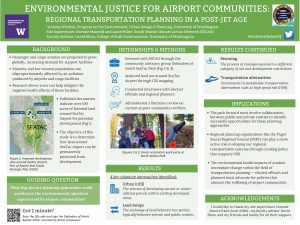ENVIRONMENTAL JUSTICE FOR AIRPORT COMMUNITIES: REGIONAL TRANSPORTATION PLANNING IN A POST-JET AGE
According to recent projections, demand for additional airport capacity support continues to grow as both passenger and cargo aviation increases globally. Although the industry comprises a large part of our modern-day transportation and logistics systems, there is insufficient awareness regarding the health and environmental impacts that airports have on nearby communities. Minority and low-income populations are disproportionately affected by air pollution produced by airports and cargo facilities. Despite research showing that trees help mitigate the negative health impacts of these facilities, expansion plans published by the Port of Seattle implicate over 100 acres of forested land around SeaTac Airport for development. The purpose of this study was to evaluate the land use around SeaTac Airport to determine the best pathway forward for protecting this forested land, as well as understanding the larger-scale transportation planning approaches that could ameliorate the environmental injustices experienced by airport communities. To accomplish this task, I evaluated the Port’s published development plans and conducted a GIS analysis of land use and tree canopy distribution around SeaTac Airport. I also completed a literature review of airport-community conflicts in the United States and interviewed elected officials and contacts at regional planning organizations. My analysis suggests the path forward must involve collaboration between public and private entities to identify successful opportunities for infill, land swaps, and rezoning of forested land currently designated as aviation commercial. Alternatives such as high-speed rail must be pursued as the environmental health impacts of aviation necessitate change within the field of transportation planning.
